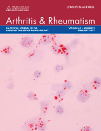Disease exacerbation by etanercept in a mouse model of alphaviral arthritis and myositis
Abstract
Objective
Mosquito-borne alphaviruses such as chikungunya virus, o'nyong-nyong virus, and Ross River virus (RRV) cause sporadic, sometimes large, outbreaks of rheumatic disease worldwide. This study was designed to test the effect of treating RRV-induced arthritis using the anti–tumor necrosis factor (anti-TNF) drug etanercept in a mouse model of rheumatic disease.
Methods
Mice were infected with RRV and treated with etanercept. Weight gain was measured, tissue viral titers were determined, and histologic changes in muscle and joint tissues were assessed.
Results
RRV-infected mice treated with etanercept showed decreased weight gain, higher viral titers in muscle, joints, and blood, and more tissue damage and inflammatory cell recruitment than RRV-infected mice without treatment.
Conclusion
Anti-TNF therapy is unlikely to be useful in treating alphaviral arthritides. During alphaviral epidemics, careful monitoring of patients being treated with anti-TNF agents may be warranted.




